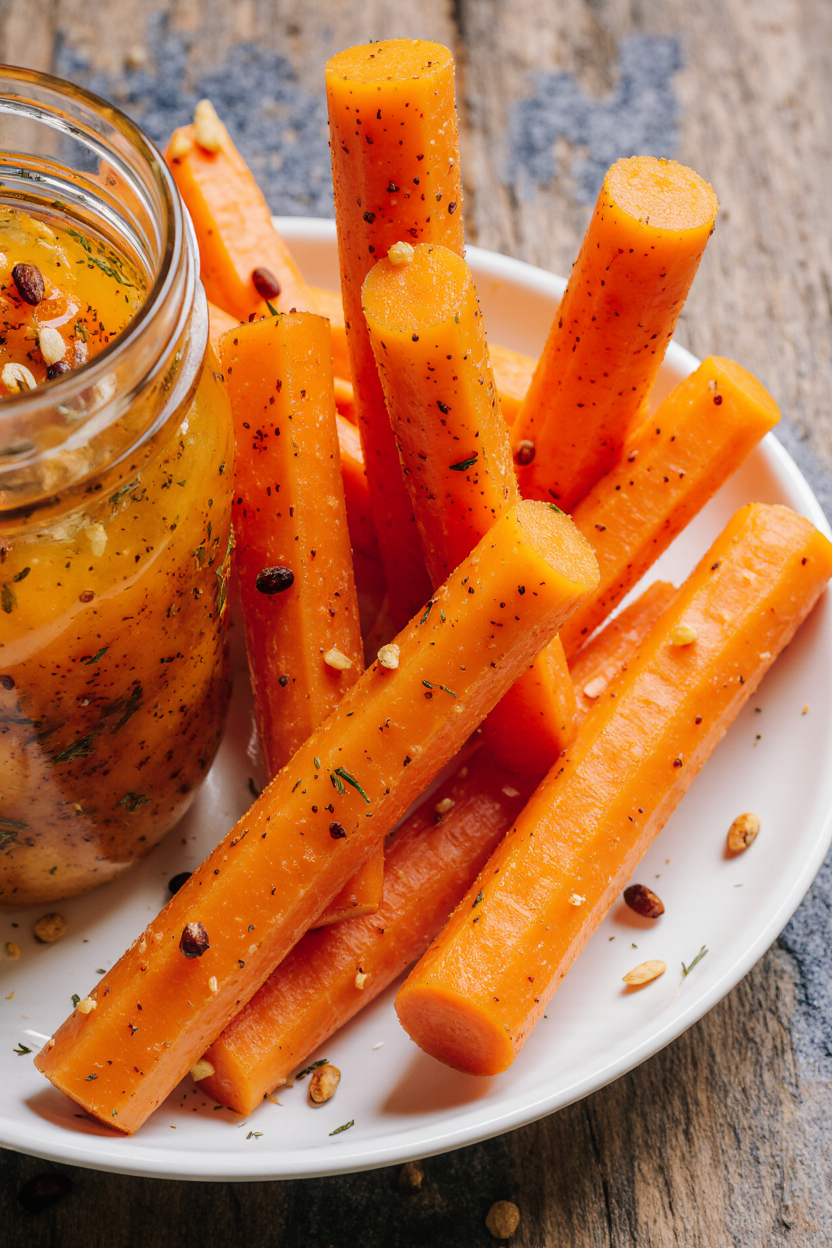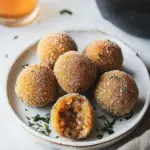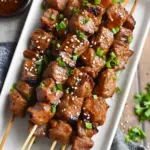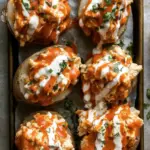The zesty punch of vinegar, the fragrant herbs, and the fiery kick of fresh chili make these pickled carrots the ultimate snack for spice lovers. Whether you serve them as a crunchy side, toss them on a salad, or eat them straight from the jar, they’ll deliver big flavor with minimal effort.
What’s especially great about this recipe is its flexibility — add more garlic, switch up the herbs, or dial the heat to your liking. No canning equipment required for the refrigerator version, and they’ll stay good for weeks. Ideal for clean eaters, snackers, and fans of big bold flavor!
Full recipe:
Ingredients:
-
6–7 medium carrots (or as many as will fit in a quart jar), peeled and cut into sticks or slices
-
1 cup white vinegar
-
1 cup water
-
1 tablespoon pickling salt
-
1 clove garlic, smashed
-
1 tablespoon honey
-
1 teaspoon dried oregano
-
1 teaspoon dried basil
-
1 teaspoon whole black peppercorns
-
1 hot pepper, sliced (optional — try jalapeño, serrano, or devil’s tongue)
Directions:
-
Peel and cut carrots into sticks or rounds according to preference. Set aside.
-
In a saucepan, combine vinegar, water, salt, garlic, honey, oregano, basil, and black peppercorns.
-
Bring the mixture to a quick boil, then remove from heat. Stir well and let cool slightly.
-
Pack carrots into a clean quart jar, leaving about 1 inch of headspace at the top.
-
Add sliced hot pepper, if using.
-
Pour warm brine over the carrots, ensuring everything is submerged.
-
Screw on the lid tightly and refrigerate for at least 24 hours to develop flavor.
-
For best taste, wait 1 week before eating. Carrots will keep in the fridge for at least a month.
Prep Time: 10 minutes | Cooking Time: 5 minutes | Total Time: 15 minutes (plus 24h+ chill time) Kcal: 38 kcal | Servings: 10 servings
Why Pickle Carrots?
Carrots are a naturally sweet vegetable, and when paired with vinegar and spices, they take on a flavor profile that’s simultaneously sharp and soothing. Unlike cucumbers, which can quickly lose their crunch, carrots remain firm and crisp even after soaking in brine for extended periods. This makes them ideal for pickling, especially if you crave a snack that’s both toothsome and refreshing.
Another reason for the popularity of pickled carrots is their adaptability. They absorb flavors exceptionally well. Whether you go for a mild garlicky blend or an all-out pepper-infused explosion, pickled carrots can be tailored to suit your taste. They also keep well in the refrigerator, often tasting better as they sit longer and the spices meld together. They’re quick to make—no fancy canning required if you’re just refrigerating them—and can last for weeks, if not longer, when properly stored.
Health Benefits of Pickled Carrots
Nutritionally speaking, carrots are a powerhouse. They are rich in vitamin A, beta-carotene, fiber, and antioxidants. Their pickled counterparts retain most of these nutrients while also offering the added benefit of probiotics—especially if you go the fermented route instead of a vinegar-based quick pickle. Probiotics promote gut health, support digestion, and even enhance immune function.
Because this recipe uses vinegar instead of fermentation, it’s not technically probiotic, but it still aligns with clean eating habits. These pickles are low in calories, gluten-free, and vegan, making them accessible to a wide range of dietary lifestyles. They contain no preservatives or artificial additives, unlike many store-bought snacks, and they help curb hunger without adding to your daily calorie count.
If you choose to include hot peppers in your recipe, you’re also adding capsaicin—a compound known to boost metabolism, improve cardiovascular health, and potentially reduce inflammation. The addition of garlic, herbs like oregano and basil, and natural sweeteners like honey, further enhances both the flavor and nutritional profile.
Customizing Your Pickled Carrots
One of the best parts of this spicy pickled carrots recipe is its customizability. You’re not locked into a single flavor profile—you can mix and match spices, change up the heat level, or even throw in other vegetables for variety.
For example, if you’re a fan of Mexican cuisine, you can adapt the recipe by using Mexican oregano, adding a splash of lime juice, and even throwing in some chili powder or red pepper flakes. This transforms the pickles into a fusion between traditional escabeche and modern brining.
If you’re new to spicy foods, start with a mild pepper like jalapeño. Prefer a stronger kick? Go for serrano, habanero, or even the fiery Carolina Reaper if you’re feeling brave. You can control how much of the pepper’s heat gets infused by leaving in or removing the seeds and membranes.
Not a fan of hot peppers at all? Leave them out! The brine still delivers tons of flavor thanks to the herbs, vinegar, and garlic. You can also sweeten the brine slightly more with a touch of maple syrup, agave, or additional honey.
In terms of herbs, dried or fresh options work—dill, thyme, and rosemary all make excellent additions. Some people even like adding whole spices like mustard seeds, coriander seeds, or cloves for a more aromatic touch.
Serving Ideas and Pairings
Pickled carrots are incredibly versatile. Here are just a few of the many ways to use them:
-
As a snack – Enjoy them straight out of the jar for a crunchy, tangy bite.
-
Charcuterie boards – They pair beautifully with cheeses, cured meats, olives, and nuts.
-
Tacos & burritos – Add them for texture and a spicy kick.
-
Salads – Slice or chop them to give any salad extra zip.
-
Sandwiches & burgers – A great substitute for pickles or slaw, adding both crunch and flavor.
-
Bloody Mary garnish – They make a colorful and spicy upgrade to celery sticks.
-
Side dish – Serve them with grilled meats, BBQ, or even alongside rice dishes to brighten the plate.
Their bright orange color also brings visual appeal to any dish. If you’re looking to elevate your plating or food photography, pickled carrots are a top-tier addition.
Refrigeration vs. Canning
This recipe is specifically for refrigerator pickles, which means it’s incredibly quick and easy. There’s no need to sterilize jars in boiling water or use pressure canners. Once you’ve poured the warm brine over your carrots, you simply screw on the lid and place the jar in the refrigerator.
That said, if you want to store these long-term outside the fridge or give them as gifts, you can preserve them via water bath canning. This process requires a bit more attention to detail (like ensuring the brine is acidic enough and removing certain ingredients like garlic for safety), but it significantly increases shelf life.
As a refrigerator pickle, these carrots stay fresh for at least a month—though they’re likely to be eaten long before that!
Tips for Success
-
Use fresh, firm carrots for the best crunch. Avoid soft or rubbery ones.
-
Cut uniformly so the pieces pickle evenly.
-
Don’t overcook the brine—you want to dissolve the salt and infuse the flavors without breaking down the herbs too much.
-
Cool the brine slightly before pouring over the carrots. Boiling hot brine can soften them too much and compromise the crunch.
-
Let them sit—they’re technically ready to eat after a day, but taste even better after a week.
Conclusion: Small Batch, Big Flavor
Spicy pickled carrots may be a small-batch snack, but they pack a big flavor punch. With minimal ingredients and effort, you can create a snack that’s equal parts healthy, bold, and addictive. This recipe is perfect for beginners looking to dip their toes into pickling, as well as seasoned home cooks searching for new ways to use garden produce.
From fridge snack to party platter, taco topping to salad star—these zesty carrots can do it all. Plus, once you’ve mastered the base recipe, the world of pickled vegetables is wide open. You can experiment endlessly with seasonings, heat levels, and combinations. It’s an entry point into food preservation that doesn’t require a major time commitment or fancy equipment.
So go ahead—grab a jar, heat up some brine, and start pickling. You’ll be amazed at how a humble carrot can transform into something so irresistibly tangy, spicy, and satisfying.






